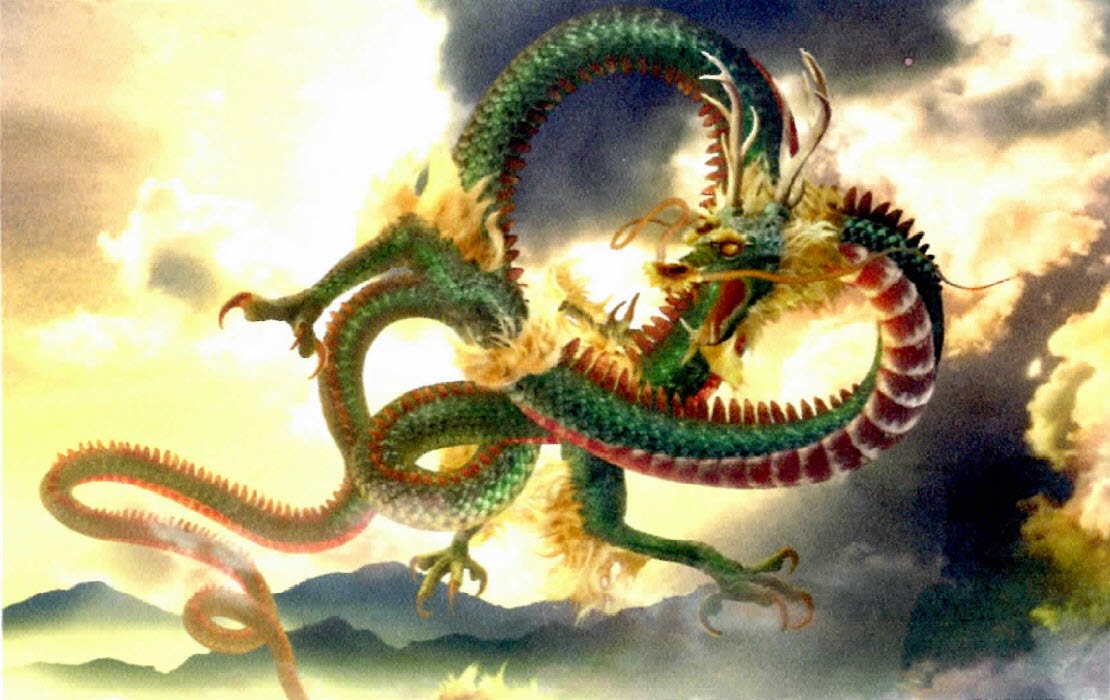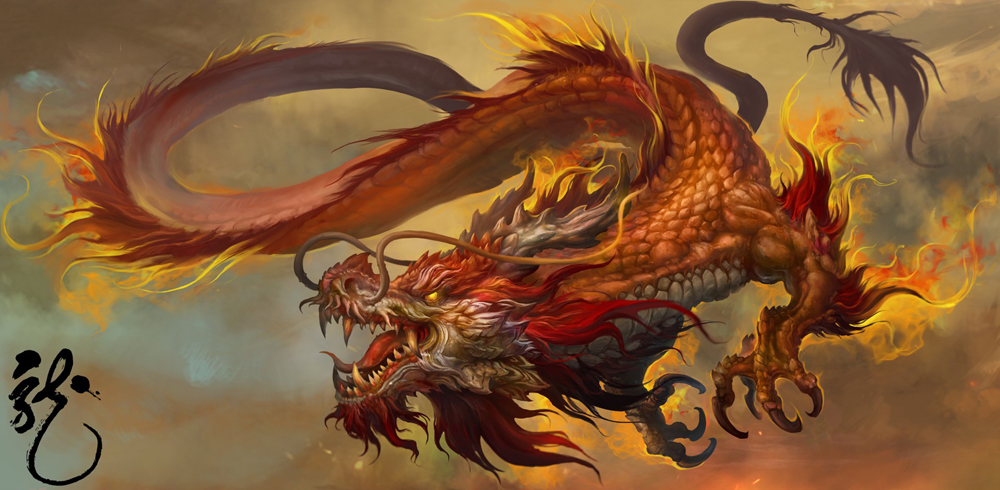By lyuesword | 06 May 2021 | 2 Comments
Dragon 龙 - The beast in Chinese mythology
Chinese Dragon (龙 lóng) – a mythical, chimeric creature of utmost importance in Chinese mythology and culture. It represents Yang, the Chinese Emperor, masculinity, imperial power, transformation, good fortune, and much more. Dragons wield tremendous power over the natural world and are particularly adept at controlling water and the weather.

Historically, the Chinese dragon was associated with the Emperor of China and used as a symbol to represent imperial power. The founder of the Han dynasty Liu Bang claimed that he was conceived after his mother dreamt of a dragon. During the Tang dynasty, Emperors wore robes with dragon motif as an imperial symbol, and high officials might also be presented with dragon robes. In the Yuan dynasty, the two-horned five-clawed dragon was designated for use by the Son of Heaven or Emperor only, while the four-clawed dragon was used by the feudatory and nobles. Similarly during the Ming and Qing dynasty, the five-clawed dragon was strictly reserved for use by the Emperor only. The dragon in the Qing dynasty appeared on the first Chinese national flag.
The dragon is sometimes used in the West as a national emblem of China though such use is not commonly seen in the People's Republic of China or the Republic of China. Instead, it is generally used as the symbol of culture. In Hong Kong, the dragon was a component of the coat of arms under British rule. It was later to become a feature of the design of Brand Hong Kong, a government promotional symbol.
Chinese Dragons are quite different from Western Dragons
The Chinese dragon has very different connotations from the European dragon – in European cultures, the dragon is a fire-breathing creature with aggressive connotations, whereas the Chinese dragon is a spiritual and cultural symbol that represents prosperity and good luck, as well as a rain deity that fosters harmony. It was reported that the Chinese government decided against using the dragon as its official 2008 Summer Olympics mascot because of the aggressive connotations that dragons have outside of China, and chose more "friendly" symbols instead.[7] Sometimes Chinese people use the term "Descendants of the Dragon" (simplified Chinese: 龙的传人; traditional Chinese: 龍的傳人) as a sign of ethnic identity, as part of a trend started in the 1970s when different Asian nationalities were looking for animal symbols as representations, for example, the wolf may be used by the Mongols as it is considered to be their legendary ancestor.

Chinese Dragons have the physical attributes of many different animals, some of which include a camel’s head, a snake’s body, a carp’s scales, a catfish’s whiskers, a stag’s antlers, an eagle’s talons, etc…
Dragons are sometimes divided into four categories: Jiaolong (蛟龙) which are scaled dragons, Yinglong (应龙) which are winged dragons, Qiulong (虬龙) which are horned dragons, and Chilong (螭龙) which are hornless dragons.
Want a unique sword? Feel free to contact us:
Email: lyuesword@hotmail.com
Website: www.lyuesword.com
Custom Sword Page: www.lyuesword.com/Custom-Sword/customization-options/Create-Your-Own-Swords

Historically, the Chinese dragon was associated with the Emperor of China and used as a symbol to represent imperial power. The founder of the Han dynasty Liu Bang claimed that he was conceived after his mother dreamt of a dragon. During the Tang dynasty, Emperors wore robes with dragon motif as an imperial symbol, and high officials might also be presented with dragon robes. In the Yuan dynasty, the two-horned five-clawed dragon was designated for use by the Son of Heaven or Emperor only, while the four-clawed dragon was used by the feudatory and nobles. Similarly during the Ming and Qing dynasty, the five-clawed dragon was strictly reserved for use by the Emperor only. The dragon in the Qing dynasty appeared on the first Chinese national flag.
The dragon is sometimes used in the West as a national emblem of China though such use is not commonly seen in the People's Republic of China or the Republic of China. Instead, it is generally used as the symbol of culture. In Hong Kong, the dragon was a component of the coat of arms under British rule. It was later to become a feature of the design of Brand Hong Kong, a government promotional symbol.
Chinese Dragons are quite different from Western Dragons
The Chinese dragon has very different connotations from the European dragon – in European cultures, the dragon is a fire-breathing creature with aggressive connotations, whereas the Chinese dragon is a spiritual and cultural symbol that represents prosperity and good luck, as well as a rain deity that fosters harmony. It was reported that the Chinese government decided against using the dragon as its official 2008 Summer Olympics mascot because of the aggressive connotations that dragons have outside of China, and chose more "friendly" symbols instead.[7] Sometimes Chinese people use the term "Descendants of the Dragon" (simplified Chinese: 龙的传人; traditional Chinese: 龍的傳人) as a sign of ethnic identity, as part of a trend started in the 1970s when different Asian nationalities were looking for animal symbols as representations, for example, the wolf may be used by the Mongols as it is considered to be their legendary ancestor.

Chinese Dragons have the physical attributes of many different animals, some of which include a camel’s head, a snake’s body, a carp’s scales, a catfish’s whiskers, a stag’s antlers, an eagle’s talons, etc…
Dragons are sometimes divided into four categories: Jiaolong (蛟龙) which are scaled dragons, Yinglong (应龙) which are winged dragons, Qiulong (虬龙) which are horned dragons, and Chilong (螭龙) which are hornless dragons.
Want a unique sword? Feel free to contact us:
Email: lyuesword@hotmail.com
Website: www.lyuesword.com
Custom Sword Page: www.lyuesword.com/Custom-Sword/customization-options/Create-Your-Own-Swords
Recently Reviews
Read MoreLeave a Reply
Your email address will not be published.Required fields are marked. *
TAGS